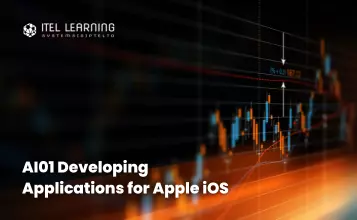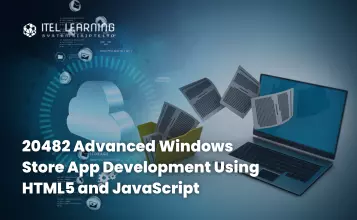Overview
iOS is the world’s most advanced mobile platform, constantly redefining what’s possible on a mobile device. Using iOS SWIFT, it’s easy to create amazing apps.
The AI01 3-day program aims to provide the necessary skills for developers to developer applications on all Apple IOS products (iPhone, iPod, iPad) for the consumer and enterprise level.
Prerequisites
Participants who wish to take up AI01 Developing Applications for Apple iOS should have familiarity with the JavaScript programming language.
Who Should Attend?
The AI01 Developing Applications for Apple iOS is beneficial towards IT professionals, software developers, mobile app developers, and aspiring mobile app entrepreneurs who are interested in developing an iOS app.
Course Outline
- Improvements over Objective-C
- Type Interface
- Type Safety
- Control Flow
- Optionals
- Strings
- Unicode
- Other Improvements
- Requirements
- Getting Xcode
- Quick Tour of Xcode
- Quick Tour of Swift
- Basic Types
- Aggregate Types
- Control Flow
- Functions
- Objects
- Generics
- Getting the Sample Code
- Getting Started with a Playground
- Custom QuickLook Plugins
- XCShowView
- XCCaptureValue
- XCPSetExecutionShouldContinueInde finitely
- Custom Modules for Playground
- Importing Your Code
- What is REPL?
- LLDB and the Swift REPL
- The Concept Behind OOP
- Indirection and Variables
- Procedural Programming
- Objected Oriented Implementation
- Type Annotation
- Identifiers
- Console Output
- Integers
- Floating-Point Numbers
- Numeric Literals
- Conversion
- Booleans
- Characters
- Strings
- Collection Types
- Arrays
- Dictionaries
- Tuples
- Optionals
- Syntax
- Notation
- Precedence
- Associativity
- Swift Operators
- Prefix
- Infix
- Bitwise Shift (precedence 160)
- Multiplicative (associativity left, precedence 150)
- Additive (associativity, left precedence 140)
- Range (precedence 135)
- Cast (precedence 132)
- Comparative (precedence 130)
- Conjunctive (associativity, left precedence 120)
- Disjunctive (associativity, left precedence 110)
- Nil Coalescing (associativity, left precedence 110)
- Ternary Conditional (associativity, right precedence 100)
- Assignment (associativity, right precedence 90)
- Postfix
- Overloading Operators
- Unary Operator
- Binary Operators
- For Loops
- For-in
- For-conditional-Increment
- While
- Do-While
- Branch Statements
- Switch
- Range Matching
- Control Transfer Statements
- Defining Functions
- Calling a Function
- Parameter Names
- Default Values
- Variadic Parameters
- Mutability of Parameters
- In-Out Parameters
- Functions Types
- Functions as Parameters
- Functions as Return Values
- Nested Functions
- Closures
- Closure Syntax
- Inferring Types from Context
- Implicit Returns
- Shorthand Argument Names
- Trailing Closures
- Capturing Values
- Commonality
- Definition
- Accessing Properties
- Value Types vs. Reference Types
- Choosing Between Classes or
- Structures
- Properties
- Stored Properties
- Lazy Stored Properties
- Computed Properties
- Property Observers
- Type Properties
- Instance Methods
- Modifying Type State
- Type Methods
- Modules and Source Files
- Access Levels
- Syntax
- Classes
- Subclassing
- Class Members
- Functions
- Enumerations
- Nested Types
- Getters and Setters
- Initializers
- Protocols
- Extensions
- Typealias
- Terminology
- Defining a Base Class
- Subclassing
- Properties
- Preventing Overriding
- Creating an Extension
- Computed Properties
- Initializers
- Methods
- Mutating Methods
- Subscripts
- Nested Types
- Object Life Cycle
- Reference Counting
- Object Ownership
- ARC
- Strong Reference Cycle
- Resolving Strong Reference
- Cycles
- Weak References
- Unowned Reference
- Strong Reference Cycles and
- Closures
- Syntax
- Properties
- Methods
- Initializers
- Protocols as Types
- Delegation
- Conformance with Extensions
- Protocols and Collection Types
- Protocol Inheritance
- Protocol Composition
- Generic Functions
- Generic Types
- Associated Types
- Primary Expressions
- Prefix Expressions
- Postfix Expressions
- Binary Expressions
- Assignment Operator
- Ternary Conditional
- Casting Operators
- Self and Super
- Closures and Functions
- Closures
- Function Calls
- Implicit Member Expression
- Optionals
- Import Process
- Interoperability
- Object Initialization
- Failable Initializers
- Properties
- Methods
- Blocks
- Object Comparison
- Type Compatibility
- Dynamic Dispatch
- Selectors
- Property Attributes
- Namespace and Class
- Cocoa Data Types
- Foundation Functions
- Core Foundation
- Interacting with C
- Importing Objective-C into Swift in the Same App Target
- Importing Swift into Objective-C in the Same App Target
- Importing Objective-C into Swift in the Same Framework Target
- Importing Swift into Objective-C in the Same Framework Target
- Importing Frameworks Using Swift in Objective-C
- NSManagedObjectContext
- NSManagedObject
- NSManagedObjectModel
- NSPersistentSotireCoordinator
- NSFetchRequest
- NSPredicate
- Creating An Application
- Defining Data Objects
- Adding an Object Editor
- Showing the Editor
- Entity Classes
- HTTP Methods
- Being Stateless
- Endpoints
- Data Formats
- Network (?????)
- The Project
- Creating a Project
- Creating A Sample
- Detail View








